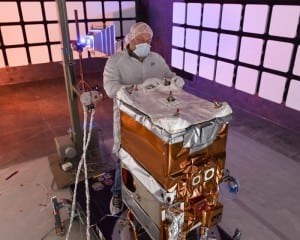Latest News

A Ball Aerospace engineer adjusts the multi-layer insulating blanket on NASA’s Green Propellant Infusion Mission (GPIM) spacecraft bus. Photo: Ball Aerospace
[Via Satellite 10-05-2015] Ball Aerospace has integrated the propulsion subsystem from Aerojet Rocketdyne into the spacecraft bus for NASA’s Green Propellant Infusion Mission (GPIM). The experimental satellite, which uses the U.S. Air Force Research Lab-developed non-toxic fuel AF-M315E, is now in system performance and environmental testing ahead of its 2016 launch date.
AF-M315E lacks the handling concerns of hydrazine, thus simplifying launch processes, and also offers increased payload space and longer mission duration. GPIM has a 13-month mission to characterize the green fuel’s performance on orbit.
“GPIM is the key mission to demonstrate a green monopropellant alternative to hydrazine,” said Jim Oschmann, vice president and general manager of civil space at Ball Aerospace. “Everyone in the industry, from NASA to our industry partners to green propellant suppliers, is eager to see 10 years of American-led research and development realized with this spaceflight mission.”
The satellite, built on the Ball Commercial Platform (BCP-100), will also carry three hosted payloads for the Department of Defense (DoD) Experiments Review Board (SERB). GPIM is Ball’s third BCP-100 mission.
Get the latest Via Satellite news!
Subscribe Now